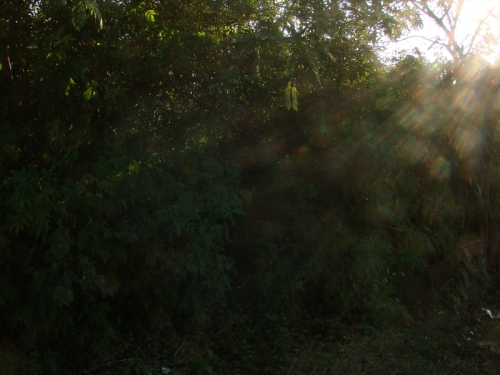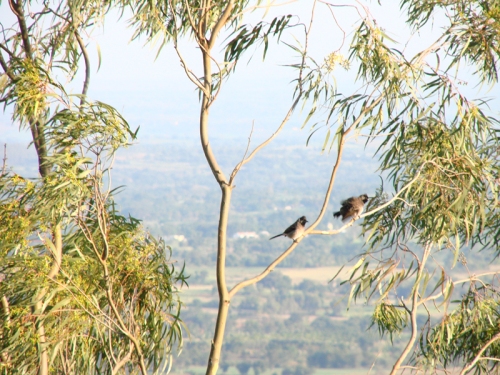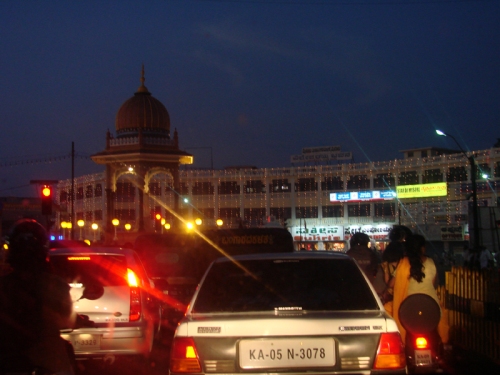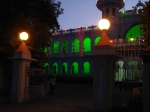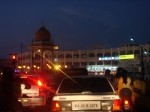I’ve moved here. Please update your bookmarks / feeds etc.
How much do I love this woman
Margaret Atwood, I mean. Her latest book is due this month and as usual, she has her finger unflinchingly on the pulse. This one’s called Payback: Debt and the Shadow Side of Wealth and it talks about the phenomenon of borrowing and owing as a cultural issue. She weaves in Faustus, Scrooge and Eric Berne to link the US economic crisis with primal human urges to get right now and pay later. She also looks at how Faustus is a generous guy, why we love the reformed Scrooge (“because, true to the laws of wish-fulfilment, which always involve a free lunch or a get-out-of-jail card, he embodies both sides of the equation”) and why we choose to go into debt — as a life script, or even as a ‘fix’.
From the Livemint extract:
In our minds — as reflected in our language — debt is a mental or spiritual non-place, like the Hell described by Christopher Marlowe’s Mephistopheles when Faust asks him why he’s not in Hell but right there in the same room as Faust. “Why, this is Hell, nor am I out of it,” says Mephistopheles. He carries Hell around with him like a private climate: He’s in it and it’s in him. Substitute “debt” and you can see that, in the way we talk about it, debt is the same kind of placeless place. “Why, this is Debt, nor am I out of it,” the beleaguered debtor might similarly declaim.
Which makes the whole idea of debt — especially massive and hopeless debt — sound brave and noble and interesting rather than merely squalid, and gives it a larger-than-life tragic air. Could it be that some people get into debt because, like speeding on a motorbike, it adds an adrenalin hit to their otherwise humdrum lives?
When the bailiffs are knocking at the door and the lights go off because you didn’t pay the water bill and the bank’s threatening to foreclose, at least you can’t complain of ennui.
It’s interesting that the passage from Dr Faustus always made me think of ‘guilt’ as akin to Hell. And debt and guilt are very closely linked, aren’t they?
What’s she also saying here is that debt is, in its own way, exciting. It gives us ‘something to think about’. And it’s probably true. How many joyful evenings in how many households have been spent discussing when the EMI on the car will be over so that the money can then be used for the EMI on a new car?
I’m one of those people who hate handling money. Don’t get me wrong. I love many of the things it can assure — certain kinds of freedom, travel, fast-speed Internet, books — but prefer to never actually have to think about it. Which means, perhaps, that this is a particular type of excitement I don’t have the stomach for. Perhaps, the fear and guilt squelch out the adrenalin. Which I why I strike big blows against feminism sometimes and let A handle the bank work. Or maybe I’m just being a clever feminist (“It’s a dirty job and someone’s got to do it,” as I rub my hands together wickedly.)
In other news, I had four glorious days away from all this vulgar talk of money last week. I was in Pondicherry and besides eating, drinking, walking, mooning at the sea, eating, drinking, I concentrated on spending the little money I have in Pondicherry’s quaint, expensive ’boutiques’ (nothing is just a ‘shop’ anymore, apparently). I like to buy heaps of seemingly small, cheap things rather than big, costly things because this allows me to feel all non-materialistic and virtuous. As a result, I have come back with many aromatic candles and enough incense for three medium-sized temples. Pictures soon. Of the place, not the incense.
Filed under Books
Chamundi, churchgoing, city lights
On Sunday, we drove down to Mysore. We ate lunch at The Metropole, which was a former guest house for the Wodeyar family’s special guests and is now a Royal Orchid property. Then, we drove up Chamundi Hill. Both of us have seen all the ‘sights’ before so we were just trying to hang out somewhere other than Koshy’s. It made for a nice change. We saw a surprised mongoose who gazed at us solemnly before scooting into the bushes. We also spent a great deal of time contemplating three extraordinary beehives at the church later. Pictures below.
The city is gearing up for Dassera and after 6.30 pm, the lights came on. Now, what I mean by that is not only the palace, which is illuminated every evening during the week up to Dassera, but almost every other public building, many shops, and most roads were glittering. It was quite overwhelming.
At the palace, there were hordes of enthusiastic people. There were also lots of red, heart-shaped balloons, which I could see bobbing over the silhouettes of a million heads or so. My pictures of the illuminated palace were taken from a moving car so they haven’t come out so well but there are plenty of images online.
Traffic management was impressive — they had these policemen and policewomen (in equal numbers) dressed nattily and wearing red feathers in their hats, and they had policemen on horses at major traffic junctions like Devraj Urs Market. It was the first time I had seen mounted policemen so I giggled and gasped, and fumed at unimportant things like moving traffic getting in the way of my camera. We also saw four elephants rehearsing their march for the parade on the final day. It’s sad that the fear of bombs have scared people off from the celebrations this year. Apparently, apart from foreigners and tourists, even locals are staying away.
Chamundi Hills, Mysore
Hotel Metropole, Mysore
St Philomena’s Church, Mysore.
City Lights
More Pictures
Filed under Culture, Personal, Photography, Places
Three poems
Three of my poems have been published in the latest issue of Pratilipi. The issue also has works by Keki Daruwalla, Sridala, Meena and Sridhar/Thayil. Do read.
Woman is a social being #1
So, as I was saying, I hate socialising after an event. Which is really awful because I either retreat into the shadows or look like I’m sulking into my drink. What I am doing actually is mulling over what I’ve seen or heard, existing for a little while in a calm bubble in my head. I should probably leave immediately after. But here’s the paradox: I like being in company. Love it, actually. Uh, without actually being in it.
It’s the same reason I sometimes go to restaurants when I can perfectly easily (and more cheaply) have the same drink in my own home. But you don’t understand, I tell A exasperatedly, ‘there will be people’. People who I will rarely know, seldom speak to, and with whom I will usually exchange a smile across the room, at most. Or an emphatic blink. I love the emphatic blink. It means so much and involves so little.
So here is what I’ve deduced: I’m deplorably lazy. I am lethargic about establishing and maintaining social contact in any active manner. I want the other person to do all the hard work. But if the other person doesn’t want to do any work, I am perfectly content with co-existing. I find it reassuring. That we all exist here, in this time, in this space. Yes, I find it a happy thought. Against all logic, I suppose. But there it is.
Filed under Personal
Dastangoi
India Foundation for the Arts (IFA) recently brought down Mahmood Farooqui and Danish Husain for a Dastangoi performance. Dastangoi is a tradition of oral story-telling, which goes back a gadzillion years to medieval Iran. The dastan-gohs (narrators), inspired by the Shahnama—a story of kings composed in verse by the famous poet, Firdausi — recited tales wherever they found willing listeners. The stories revolved around commonly loved themes. Brave princes. Evil kings. Lovable tricksters called ‘ayyars’. Then there was the usual assortment of demons, magicians, jinns and other evil people. Dan (as Husain is popularly known) and Farooqui have resuscitated this dying art and have been performing for a couple of years, but I think this was their first time in Bangalore.
I tend to believe I’m a bit aurally challenged. Hearing tests have said that my hearing is perfectly sound but what do they know? Gah. In any case, I usually prefer to read rather than listen. Which is why I was faintly skeptical about a Dastangoi performance. I mean, I had heard only good things but would they really hold my attention with two hours of story-telling? I was happily gobsmacked to find that they did indeed.
The stories Hussain and Farooqui perform are mainly from the Dastan-e-Amir-Hamza and the first episode was a story in which Amar Ayyar cleverly tricks a jadugar and gets into his palace by pretending to be a woman. Early on, Farooqui told us not to balk if we didn’t get all the words. A necessary warning in Bangalore where many people don’t know Hindi, and therefore would find it harder to understand Urdu. ‘Hold the thread of the story’ and you’ll be fine, he said. At least, that’s what I understood. And going by the post-performance discussion, that seemed to have worked well for most people. With my limited exposure to Hindustani, I missed some of the more poetic descriptions. But I found that it didn’t matter too much. Urdu is such a mellifluous language; I just let the words wash over me, enjoying their warm soothe, trying to hold on to the thread like he said.
When the Amir Hamza story ended in a little more than an hour, I wondered if attention would flag. It may have if they had continued on a similar tack. I like clever con artists and stupid, vain villains just as much as the next person, but I need to close the book on them at intervals. But they quickly launched into a very different type of story — a script they have written themselves about the Partition. Using an ancient art form to communicate something with so much contextual relevance is clever and, if not done well, can fall flat on its face. But they did it well. So well in fact that I found myself moved anew by their narrative on corpse-filled trains, lost houses, abducted women. These are stories one has heard before and there is the danger of feeling jaded. But there was an intensity they brought to the telling, an authenticity to the characters they spoke about that was engaging. I saw many women surreptitiously wiping their eyes when they talked about how abducted women chose the protection of the rapists and kidnappers because things could be so much worse.
Farooqui says in this interview:
The Dastan-e-Amir Hamza, which runs into 46 volumes, is ostensibly about the life of Hamza, the paternal uncle of the Holy Prophet Mohammad. At one level, it purports to be an account of the triumph of Islamic armies over infidels and worshippers of other Gods. But in its essence, it is a highly secular narrative. Its modern day equivalent would be Tolkien’s Lord of the Rings, or even Hindi cinema. Its world is fascinating, full of magic and sorcery and tricksters, tilisms governed by fantastical characters and qualities. It is an unstoppable riot of names, places, scenes, descriptions, battles, love-making, seduction. It is really about letting go.
There was a sense of this ‘letting go’ that they brought to their Dastangoi performance. They used plenty of tonal shifts to ensure that the telling did not become a drone, but in places they were also frankly loud or emotive. In one scene, they did a hammy crying routine. Quite over-the-top and utterly hilarious. Yet, in places, they were restrained. And it was this careful control over the tension between emotional spill and subtlety that gave the performance texture. Dastangoi itself, as an art form, lies somewhere in between recitation and theatre, and stepping stealthily in between these lines is something that probably defines its success.
The duo worked well together. At a very obvious level, their voices complemented each other. When one picked up from where the other left off, there was a pleasing shift, not jarring but clear. There was something underlying as well. They were dressed alike and there was no conscious effort to delineate themselves but each had a strong, distinctive personality, which made for nice interplay. For instance, Dan (or his dastan-goh persona) seemed more self-assuredly aware of his own cunning and it made sense when he impersonated a beautiful woman to get into the jadugar’s palace. Farooqui’s quiet thoughtfulness was excellent for the second part when he read out the correspondence between a Hindu in India and a Muslim in Pakistan on the insurance papers one has left behind.
On an entirely separate note, ITC Windsor had set up a cute, little stage with bolsters and all but I couldn’t help imagining how a more baithak-style gathering would have felt. Of course, it would be hard to fit as many people in. But maybe, next time. Anyway, afterwards, I did what I normally do when I’ve enjoyed a performance. I retreated into a corner with my drink. And refused to socialise like other nice people do. And had to apologise for my rudeness to Dan on FB. But all that’s another self-indulgent story and I will get into it in another post.
Things i am liking tonight
 Aravind Adiga’s White Tiger. So far. Despite the tense straining of muscles I generally feel against things hyped and vulgarly in the news.
Aravind Adiga’s White Tiger. So far. Despite the tense straining of muscles I generally feel against things hyped and vulgarly in the news.
I’m trying to get over this perversity of not being able to watch, read, enjoy things when other people tell me they are so-very-enjoyable. Sometimes they really are.
Anyway, I’ve just started and I like the gritty texture, the grime that Adiga unabashedly describes. Mud, lizards, buffaloes, black oozing rivers. I have a fondness for the unpretty image done well.
Also, Eavan Boland‘s poem Love. Here’s an extract:
And yet I want to return to you
on the bridge of the Iowa river as you were,
with snow on the shoulders of your coat
and a car passing with its headlights on:I see you as a hero in a text —
the image blazing and the edges gilded —
and I long to cry out the epic question
my dear companion:
Will we ever live so intensely again?
Read the full poem here.
and
my trusty camera. There is a dilemma attached to this one. I like photographing people more than things, or even places. But I feel uncomfortable doing it. Voyeuristic. Violative, like Sontag said. Especially since I usually like faces with something unusual about them — some sadness, quirk or peculiarity. And this is natural for someone who considers herself sad, quirky and peculiar, I suppose. But am I responding to the person or to some hidden quality in the person that I am trying to unearth? And how separate are the two things? And how much of it is about recognition of something familiar, emotional kindred?
So I’m one of those people who love taking pictures of people but will never ask. Unless I’m really drunk or really sure that they don’t mind. Which makes me a lousy, cowardly sort of photographer. I intend to get over this hangup soon but tonight, I was in no mood to make a big effort towards “springing from the platonic conception” of myself so I photographed Dobby, and lamps and things.
Filed under Personal, Photography, Poetry
Look Who We Have Coming to Vogue
Vogue India’s August issue features designer bibs (like the Fendi bib the child in the photo is wearing), handbags, clutches, umbrellas–all modeled by the aam aadmi. Of course, considering that prices for brands like Hermes Birkin and Burberry can range between $200 and $10,000, this is the only time they will ever get near them. Luxury brands have usually been accused of ignoring the average person in India. This, apparently, is Vogue’s answer to that. Vogue’s logic according to this story:
Vogue India editor Priya Tanna’s message to critics of the August shoot: “Lighten up,” she said in a telephone interview. Vogue is about realizing the “power of fashion” she said, and the shoot was saying that “fashion is no longer a rich man’s privilege. Anyone can carry it off and make it look beautiful,” she said.
“You have to remember with fashion, you can’t take it that seriously,” Ms. Tanna said. “We weren’t trying to make a political statement or save the world,” she said. (emphasis mine)
Seems to me like she’s contradicting herself a bit there. Are we supposed to believe in the ‘power of fashion’ which is going to elevate these poor people and save their lives with $100 Fendi bibs? Or are we supposed to ‘lighten up’ about poverty and have a good chuckle?
One way of looking at it is that this was an earning opportunity for these people. In which case, I’m curious to know whether they were paid as much as regular models or not. I haven’t seen the magazine so I don’t know if the editors have put this in some sort of context or are tying this up with any social programmes. But it’s a little telling that the shoot does not name the models / people in the captions. Only the brands of the accessories.
What do you think?
Two Things
Upcoming writers, photographers and musicians, the annual Toto Funds the Arts awards are here again and anyone below the age of 30 can apply in these categories. Here are the details on the writing awards. If you want details on the other awards, write to me and I’ll forward them you can just click here.
TOTO FUNDS THE ARTS (TFA) invites entries for its fourth annual TOTO awards for Indian creative writers in English. Two cash awards of Rs. 25,000 each will be given in January, 2009. Entries are only invited from young people — over the age of 18, and who have not celebrated their 30th birthday before 1 January 2009. The spirit of the Toto Awards is to identify promise and encourage young talent. Therefore, do not submit an entry if you are already an established writer.TFA is looking for entries in three genres –– short plays, short stories and poetry.
The submissions should not exceed 7,500 words. You can submit any combination of your writing in the above genres, as long as the entire submission is within the stipulated word limit. Entries should reach TOTO FUNDS THE ARTS (TFA) by 4 October 2008 at the latest. There will be no extension of the submission date. Address:TOTO FUNDS THE ARTS (TFA), H 301 Adarsh Gardens, 8th Block, 47th Cross, Jayanagar, Bangalore 560 082, Phone: 080-26990549
Entries should be sent in soft e-mail copy to totofundsthearts@yahoo.com as well in hard copy form to the above address. Please address queries to the same e-mail ID.
THE FINE PRINT:
Entries must be accompanied by a signed statement confirming the applicant’s date of birth, whether the applicant’s work has been published in print (give details), and also affirming that the submitted work is original. Please ensure that the hard copy does not carry your name on it. Submitted entries will be given code numbers to protect applicants’ identities from the jury during the judging process. Submitted material will not be returned. The decision of the TFA jury is final and cannot be contested in any forum.
Also, Caferati and LiveJournal are inviting entries for Quicktales, their flash fiction contest. Details here.
UPDATE: Toto Funds the Arts has just started their own blog. If you’re in Bangalore, it’s a great way of staying updated on readings, events etc. See here.
Filed under Poetry
bLooDy bRilliAnt
 So Orange Jammies at Wisdom Wears Neon Pyjamas has, in all her infinite wisdom, decided to give me this. And because I’m such a generous soul, I am getting over my love of shiny things and actually passing this on. Well, actually, because the rules say so. 😀
So Orange Jammies at Wisdom Wears Neon Pyjamas has, in all her infinite wisdom, decided to give me this. And because I’m such a generous soul, I am getting over my love of shiny things and actually passing this on. Well, actually, because the rules say so. 😀
The Brilliant Weblog award is a prize given to sites and blogs that are smart and brilliant both in their content and their design. The purpose of the prize is to promote as many blogs as possible in the blogosphere.
- When you receive the prize you must write a post showing it, together with the name of who has given it to you, and link them back.
- Choose a minimum of 7 blogs (or even more) that you find brilliant in their content or design.
- Show their names and links and leave them a comment informing they were prized with the Brilliant Weblog Award.
- Show a picture of those who awarded you and those you give the prize (optional).
- And then we pass it on!
So the Brillante Weblog Award goes to…
1. Iz for Audacious: She’s pink. She’s gutsy. She’s hilarious. She writes about family and love and dogs (and often love for dogs) with equal aplomb. She does the personal post with such style and she’s more fun than cheesecake.
2. Anita Bora for Just A Little Something: Travel stories. Food stories. And great photographs of places all over India. She’s a window into the life I wish I was living.
3. Gopal for Which Main, What Cross: He captures my city so lovingly, frame by frame. His images get the soul of this in-flux, traffic-weary, often confusing city and I go back to them to remind myself of it.
4. Karthik and Doz for Etcetera: As they say, their blog’s got a point, if only you can find it. While you’re at it, there’s heaps of interesting stuff to read.
5. Shilo for Across the Universe: Illustrations, photographs and other flights of imagination — all of it charming.
Okay, I know it says 7 but I’m going to stop here. Have fun checking out the links. Ta!
Filed under Personal

